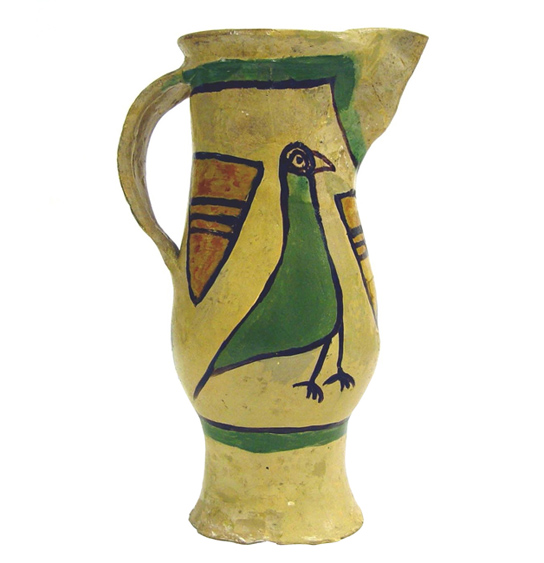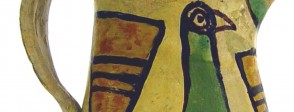
Description
The appearance of the jug is immediately bright and charming. It is made from white clay and the outside has a clear, smooth glaze. The decoration shows two large, copper-green birds and three yellow-brown shields. There is a strap handle and a large parrot-beak spout. The overall effect is that the body of the bird is reflected in the shape of the jug while the spout resembles its beak.
Origin, status and purpose
The highly distinctive style of this jug means that we know that it was made between 1275 and 1300 near Saintes, the capital of the Saintonge region in southwest France. Other jugs from the same time and place feature images of plants or have abstract designs. Some unusual examples even include three dimensional human figures. While Saintonge pottery is not rare in Britain, most pottery found by archaeologists here was made locally.
The jugs signify Britain’s strong trading links with south-west France and are a by-product of the enormously important wine trade. In the British Isles, remains of such jugs are usually found in large ports such as London, Southampton, Bristol, Cardiff and Waterford although they also appear in excavations of inland castles, abbeys and homes of the wealthy.
The jug was designed to hold wine, a drink associated with wealthier members of English society. While it may not look particularly sophisticated in some ways, the use of different colours, the clarity of the images, the whiteness, smoothness and relative thinness of the clay all indicate that this was, in its day, a refined piece of pottery. It is often claimed that medieval people in Britain drank ale, beer or wine in preference to water, but the siting of settlements near rivers, streams and springs suggest that this was unlikely, although it may have been more true of larger towns and cities where water supplies were easily contaminated. Either way, jugs of quality, such as this, were used for wine by those who could afford to drink it regularly.
Wine, trade and war
Two years before he took the English throne in 1154, Henry II married Eleanor of Aquitaine, ruler of most of south west France. Once he was king, Henry therefore ruled a great Anglo-French empire stretching from Hadrian’s Wall to the Pyrenees. English merchants created strong links with the wine industry of Gascony and Saintonge and gradually reduced England’s own wine industry and its trade with northern France. In 1308, at the peak of the trade and not long after this jug was made, 5 million gallons of wine were imported from Aquitaine. The wine was transported in large barrels called tuns - this is the root of the ton by which we measure large loads. Despite pirate raids on ships in the English Channel, wine merchants grew rich and the taxes they paid on their trade created wealth for English kings. This added to French resentment that English kings ruled such a significant part of France and that they even laid claim to the French crown. From 1337 to 1453 these disputes were the grounds for the Hundred Years War between English and French kings.
More information
Medieval jug
Information about this specific jug.
http://www.britishmuseum.org/explore/highlights/highlight_objects/pe_mla/s/saintonge_jug.aspx
Saintonge pottery
A helpful guide to Saintonge pottery of this type.
http://yorkcommunityarchaeology.pbworks.com/w/page/37829406/Pot%20Spot%3A%20Pretty%20Polychromes
Saintonge pottery found in sites in Wales
http://www.museumwales.ac.uk/rhagor/article/1944/
Medieval pottery processes
A summary of the various processes involved in making medieval pottery.
http://www.ashmolean.org/PotWeb/PotFing9.html
Henry II’s Angevin Empire
Map showing the extent of Henry II’s Angevin Empire. Saintonge is the region to the north and east of the estuary that leads to Bordeaux.
http://www.fitzmuseum.cam.ac.uk/gallery/normans/gallery/coin_89.htm
A myth that water was not commonly drunk in the middle ages
A blog that suggests that it is a myth that water was not commonly drunk in the middle ages, with a further link to information about wine in medieval France.
http://leslefts.blogspot.com.au/2013/11/the-great-medieval-water-myth.html
The sea trade and daily life
Excerpt on sea trade and daily life from: Richard Gorski (ed.), Roles of the Sea in Medieval England, Boydell Press, 2012.
http://books.google.co.uk/books?id=GT2zJjkn90QC&pg=PA172&lpg=PA172&dq=medieval+sea+trade+england+gascony+france&source=bl&ots=52HM2rQB1o&sig=5D77yms7a4jMXJm317uBiaD4fr8&hl=en&sa=X&ei=VLo3VIKPI-XNygPh8YC4Bw&ved=0CCcQ6AEwAQ#v=onepage&q=medieval%20sea%20trade%20england%20gascony%20france&f=false
History of Winchelsea
History of Winchelsea, an important port for the import of wine from France.
http://www.winchelsea.net/visiting/winchelsea_history.htm
A bronze ewer
Information about a bronze ewer from the court of Richard II of England; found in the Asante kingdom (present-day Ghana).
http://www.britishmuseum.org/explore/highlights/highlight_objects/pe/a/asante_ewer.aspx
More information
-
Medieval jug
Information about this specific jug.
Source: britishmuseum.org
-
Saintonge pottery
A helpful guide to Saintonge pottery of this type.
Source: yorkcommunityarchaeology.pbworks.com
-
Saintonge pottery found in sites in Wales
Source: museumwales.ac.uk
-
Medieval pottery processes
A summary of the various processes involved in making medieval pottery.
Source: ashmolean.org
-
Henry II’s Angevin Empire
Map showing the extent of Henry II’s Angevin Empire. Saintonge is the region to the north and east of the estuary that leads to Bordeaux.
Source: fitzmuseum.cam.ac.uk
-
A myth that water was not commonly drunk in the middle ages
A blog that suggests that it is a myth that water was not commonly drunk in the middle ages, with a further link to information about wine in medieval France.
Source: leslefts.blogspot.com.au
-
The sea trade and daily life
Excerpt on sea trade and daily life from: Richard Gorski (ed.), Roles of the Sea in Medieval England, Boydell Press, 2012.
Source: books.google.co.uk
-
History of Winchelsea
History of Winchelsea, an important port for the import of wine from France.
Source: winchelsea.net
-
A bronze ewer
Information about a bronze ewer from the court of Richard II of England; found in the Asante kingdom (present-day Ghana).
Source: britishmuseum.org


